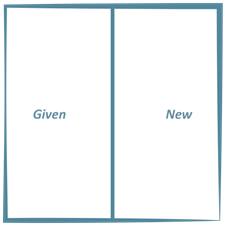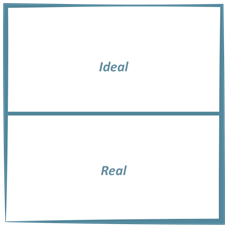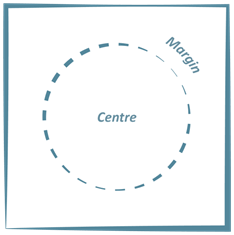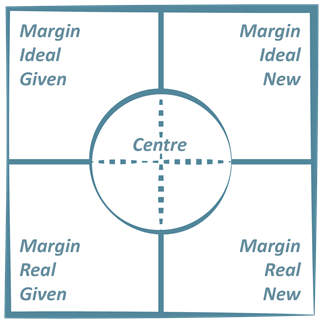Information value is one of the three principles of composition of texts. Discussing the meaning of composition and multimodal text, Kress and van Leeuwen explain that composition relates the representational and interactive meanings of the image to each other through three systems: information value, salience and framing (2006, 177). Information value is given by the placement of elements and it is attached to the various sections of the image. These sections or zones involve left and right, top and bottom, and centre and margin. Information value together with salience and framing applies to both single images and composite or multimodal texts, as well as in spatial, temporal or integrated compositions (e.g. paintings, magazines, speech, music, dance, film, television).
 Given that composition is discussed here in regard to semiotic modes, the information value as a component of semiotic space is described according to the arrangement of the elements and through further interpretation of the text. The distinction between left and right is perceived as a source of meaning, and it indicates the relevance of information for the audience in particular contexts. Throughout different texts and contexts, left is often associated with the ‘general’, ‘past’, ‘recoverable’ and subsequently ‘Given’, while right is associated with the ‘specific’, ‘present’, ‘not recoverable’ and therefore ‘New’ (van Leeuwen 2005; Halliday 1985).
Given that composition is discussed here in regard to semiotic modes, the information value as a component of semiotic space is described according to the arrangement of the elements and through further interpretation of the text. The distinction between left and right is perceived as a source of meaning, and it indicates the relevance of information for the audience in particular contexts. Throughout different texts and contexts, left is often associated with the ‘general’, ‘past’, ‘recoverable’ and subsequently ‘Given’, while right is associated with the ‘specific’, ‘present’, ‘not recoverable’ and therefore ‘New’ (van Leeuwen 2005; Halliday 1985).
 The vertical dimension refers to the placement of the information from top to bottom, graduating from general on the top to more specific meaning at the bottom (Kress and van Leeuwen 2006; Holsanova, Rahm & Holmqvist 2006). The upper section is considered to give idealized or generalized gist of the information and it is presented as the ‘Ideal’. On the other side, the lower section in compositions is perceived as specific, informative and practical, and presented as the ‘Real’.
The vertical dimension refers to the placement of the information from top to bottom, graduating from general on the top to more specific meaning at the bottom (Kress and van Leeuwen 2006; Holsanova, Rahm & Holmqvist 2006). The upper section is considered to give idealized or generalized gist of the information and it is presented as the ‘Ideal’. On the other side, the lower section in compositions is perceived as specific, informative and practical, and presented as the ‘Real’.
 The information value of centre and margin is the principle of composition analyzed, among others, by Arnheim who demonstrates the principle through the analysis of Buddhist paintings. The central position is the crucial element of the composition, where a circle of subordinates surrounds the central figure (Arnheim 1982). Additionally, Kress and van Leeuwen note that in contemporary Western visualization “most compositions polarize elements as Given and New and/or Ideal and Real” (2006, 194). It should also be added that Given-New and Ideal-Real can be combined with Centre and Margin (e.g. triptych).
The information value of centre and margin is the principle of composition analyzed, among others, by Arnheim who demonstrates the principle through the analysis of Buddhist paintings. The central position is the crucial element of the composition, where a circle of subordinates surrounds the central figure (Arnheim 1982). Additionally, Kress and van Leeuwen note that in contemporary Western visualization “most compositions polarize elements as Given and New and/or Ideal and Real” (2006, 194). It should also be added that Given-New and Ideal-Real can be combined with Centre and Margin (e.g. triptych).
Moreover, van Leeuwen (2005) delineates one more dimension of semiotic space to which he gives a name ‘the third dimension’, and it relates to three-dimensional structures. This dimension concerns the placements of the elements on the front or the back, on the left or the right side, and on the top or at the bottom. With three-dimensional structures, front and back may or may not be polarized, while the left or the right side are interchangeable and, therefore, relatively instable. The bottom is rarely semiotic because it is often out of sight. The top, on the other hand, can be pertinent and easily visible.

The dimensions of visual space
Citing this entry
Jovanovic, Danica. 2015. “Information value.” In Key Terms in Multimodality: Definitions, Issues, Discussions, edited by Nina Nørgaard. www.sdu.dk/multimodalkeyterms. Retrieved dd.mm.yyyy.
References
Arnheim, R. (1982): The Power of the Center: A Study of Composition in the Visual Arts. Berkeley: University of California Press.
Halliday, M.A.K. (1985). Introduction to Functional Grammar. London: Edward Arnold.
Holsanova, J., Rahm, K. and Holmqvist, K. (2006). Entry points and reading paths on newspapers spreads: comparing a semiotic analysis with eye-tracking movements, Visual Communication 5(1): 65-93.
Kress G. and van Leeuwen, T. (2006). Reading Images: The Grammar of Visual Design. London: Routledge.
Van Leeuwen, T. (2005). Introducing Social Semiotics. London: Routledge.